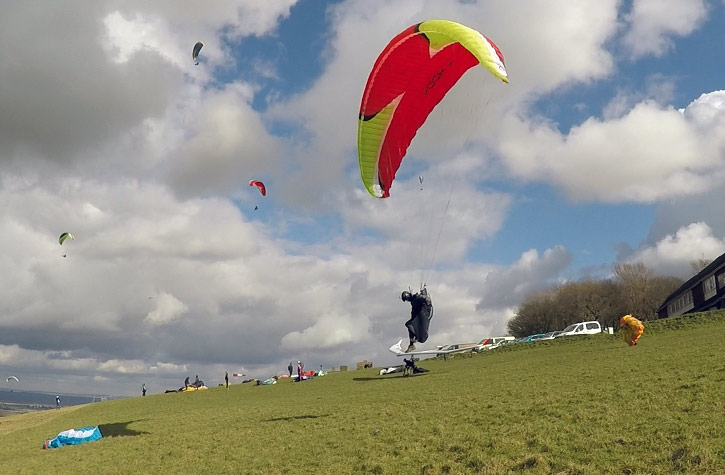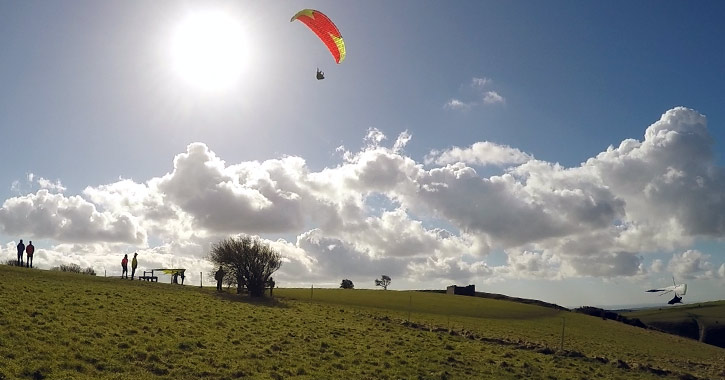
There are a few pilots who consider that because the rules of the air give them priority it is always other people who have the responsibility to get out of their way. But this is not true, either in flight, on approach, or in the landing area. All pilots share the ultimate responsibility to avoid collisions; the Rules of the Air help determine priority, but if the other party isn’t aware of your presence, or is unable to manoeuvre, no rule is going to help you.

I witnessed a mid-air collision in France (fortunately without serious injury) where, during several seconds before the impact, the first pilot had a clear view of the other but was certain that they had ‘right of way’. All the way to the scene of the accident they were waiting for the second pilot to take avoiding action, but the other pilot was not aware of the imminent collision until the very last instant as the first pilot’s glider was obscured by the sun and the second pilot’s wing.
Similar issues can arise on approach and in landing areas. The relevant rules are that; an aircraft landing, or on final approach to land, shall have right-of-way over other aircraft in flight or on the ground; when landing an aircraft shall leave clear on its left any aircraft which has landed, is already landing or is about to take off; and, once landed an aircraft shall move clear of the landing area as soon as possible. However, even at airports with ATC managing movements in the air and on the ground, the unexpected can occur and sometimes a landing aircraft has to abort and ‘go around’ because of an obstruction on the runway.

None of our sites can have such well controlled circumstances, even ones with well organised marshalling systems. Whilst on some of the sites we fly there are large top and bottom landing areas which mean that conflicts between already landed and approaching aircraft are uncommon, this is certainly not true everywhere. Sometimes the available flat area is quite small, particularly from the perspective of a hang glider on approach at an airspeed of 45km/h and perhaps needing a significant part of 100 metres in which to make a comfortable approach and landing. Paragliders have the advantage of landing more slowly, not being influenced by ‘ground effect’, and being able to come to a complete stop often as soon as the pilot touches the ground. Given a good approach this makes the requirement for paragliders to have a long clear glide and overshoot area largely unnecessary. Indeed paragliding accuracy competitions show just how little ground area can be required to land a paraglider.
Whilst a hang gliding spot landing competition can result in a number of gliders completing their landings close to a target, a much larger clear area is required for the glider’s approach, and the effect of the ground on a hang glider’s glide angle is significant. When any wing gets close to the ground (less than a wing span) its efficiency is increased markedly by this ‘ground effect’, and the distance it glides is extended. This is particularly significant for higher aspect ratio, competition hang gliding wings, and with this assistance even a slight down-slope can extend a hang glider’s glide to an extent that can surprise even the pilot!
All of this means that it is important whenever a pilot has landed (whatever aircraft they are flying) to first check for other approaching gliders before moving clear of the landing area. Here again paraglider pilots have an advantage; their wings are likely to be flat on the ground, with the pilot looking back the way they have landed. In contrast hang glider pilots are under their wings, with very limited visibility above and behind. For them, it is essential that they establish the position of other gliders on approach before moving. A stationary target is much easier to avoid than one that moves in an unexpected way. But whatever your aircraft, you do have a duty to clear the landing area as quickly as possible, leaving de-rigging, instrument adjustments, packing away, radio and telephone messages, or stories of ‘There I was … ’ until after you have moved to a suitable place. But, however assiduously this rule is followed, there are always circumstances in which it is not possible; a hang glider with a broken upright, or a paraglider pilot with an injured leg are only two possibilities; in addition there is always the risk of spectators or animals causing an obstruction.
So from the approaching pilot’s point of view, what can they do to help themselves? Their main defence is always a good landing approach that embraces the possibility of a change of plan - or even landing location - being required at any stage. And, when top landing, keeping in mind that overshooting can be a handy ‘abort’ option. For those already landed, try to ensure that you are not the cause of the next unintended conflict for space on the ground, and that as well as setting a good example, you also encourage other pilots you fly with (no matter what their apparent expertise or authority) to be courteous and safe after they have touched down.
Republished with kind permission of Skywings Magazine
